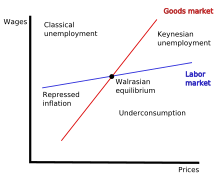Involuntary unemployment
Azariadis showed that given risk-averse workers and risk-neutral employers, contracts with the possibility of layoff would be the optimal outcome.
Shapiro and Stiglitz, developers of an influential shirking model, stated "To us, involuntary unemployment is a real and important phenomenon with grave social consequences that needs to be explained and understood.
"[9] Mancur Olson argued that real world events like the Great Depression could not be understood without the concept of involuntary unemployment.
It is, on the contrary, a theoretical construct which Keynes introduced in the hope it would be helpful in discovering a correct explanation for a genuine phenomenon: large-scale fluctuations in measured, total unemployment.
"[13] Along those lines real business cycle and other models from Lucas's new classical school explain fluctuations in employment by shifts in labor supply driven by changes in workers' productivity and preferences for leisure.
In these models, unemployment is voluntary in the sense that a worker might choose to endure unemployment during a long search for a higher paying job than those immediately available; however, there is an involuntary element in the sense that a worker does not have control of the economic circumstances that force them to look for new work in the first place.

